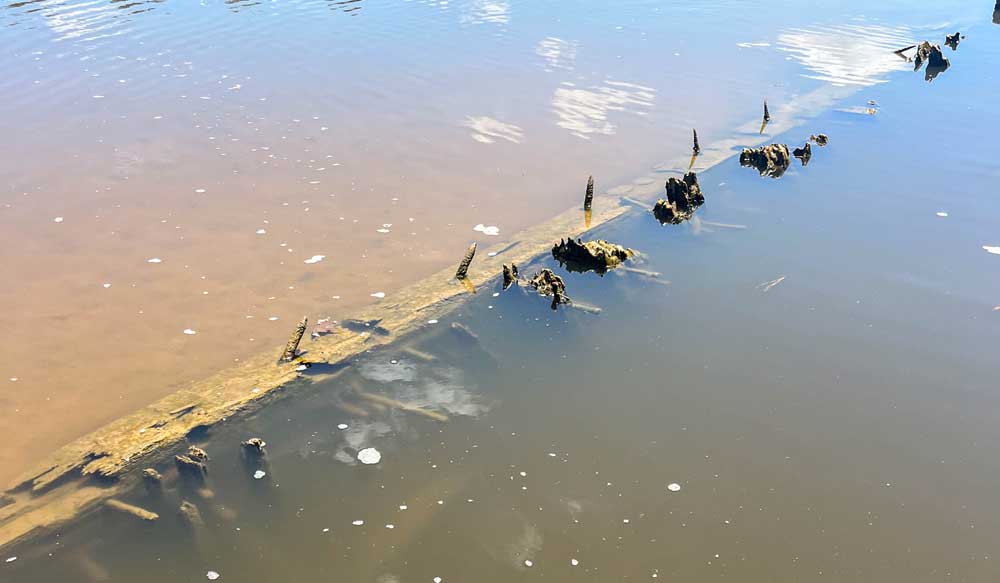Texas Historical Commission confirms shipwreck in an East Texas river dates to World War I era
Published 5:40 am Thursday, August 31, 2023

- The Texas Historical Commission (THC) recently confirmed that a shipwreck discovered in the Neches River dates back to the World War I era.
A piece of history made itself visible this month due to Texas drought conditions. A summer heatwave and low rainfall revealed a hidden shipwreck at the bottom of the Neches River.
The Texas Historical Commission (THC) confirmed the shipwreck discovered in the River dates back to the World War I era.
The wreck was reported to State Marine Archeologist Amy Borgens by Susan Kilcrease of the Ice House Museum early on the morning of Aug. 18. The coordinates for the discovery were forwarded by Bill Milner on Aug. 22.
With the coordinates, the shipwreck location can be compared to the Marine Archeology Program (MAP)’s shipwreck geodatabase. This database originated as a paper file reference system in 1971 and now contains 1,907 records. The database has 1,714 undiscovered shipwrecks and 182 recorded archeological sites in Texas.
It also includes 11 shipwreck sites in the Louisiana side of the Sabine River. Once the coordinates were provided, the wreck(s) location was compared to the database and the sonar data collected by the THC in 2019. It was originally one of eight vessels reported to the agency in 2004, according to Borgens.
“This shipwreck was part of a fleet of merchant steamships under construction through the government and also private contracts in Beaumont, Texas. The U.S. Shipping Board in 1917 created the Emergency Fleet Corporation to build a ‘bridge of ships’ to help restore US maritime commercial activity impacted by allied vessel losses during World War; often these losses were the result of submarine warfare,” she said.
“The Gulf District was comprised of five cities, four in Texas including Beaumont, Orange, Houston, and Rockport with Beaumont producing the largest number of these Texas vessels.”
“When the war ended, there were many of these ships in production that were unfinished. Since they were made of wood, there was not a market for these ships, outside of wartime use, and most in the Beaumont area were sold for scrap,” Borgens said. “Most of these vessels were of the Ferris-type and were nearly 282 feet long when completed.”
Borgens, who is the program coordinator for the MAP in the Archeology Division of the Texas Historical Commission, said many of the vessels were simply abandoned in rivers.
“There are more than 20 of these wrecks in the Neches River and there are another 15 in the Sabine River,” she said.
“Of the WWI shipwrecks, there are approximately 40 intentionally abandoned wooden vessels in East Texas rivers, including those in the Louisiana Sabine, and one suspected EFC shipwreck near Rockport,” she said. “There are also several WWI EFC ships that were transitioned to service after the war and abandoned when they were no longer of use or could not be repaired – this includes the concrete vessel Selma and Durham at Galveston.”
“There are two other EFC-era vessels that wrecked near Port Aransas – the wooden ETC steamship Utina and the steel-hulled tug Baddacock.
Borgens said weather conditions play a significant role in finding artifacts like the shipwrecks and credits the current drought and high temperatures for making them visible to boaters.
“Shipwrecks can be exposed during droughts, after storms, or at low tide; the Neches is tidally influenced. Changes in a river’s course can also cause wrecks to erode out of the riverbanks, though that is not suspected to be an issue in the area of these shipwrecks,” she said. “Often these vessels are underwater, alongside riverbanks, or along the coast where they can be buried under beach sand. Those in shallower waters are reported to the agency during times of low water, droughts, and often after storms and hurricanes.”
“I can receive several such reports a year, but typically not every year. It just depends on the weather and circumstances,” Borgens added.
Archeological sites on Texas public land are protected by the Antiquities Code of Texas. Dependent on where shipwrecks are located, there are additional protections at the federal level for federally funded and permitted projects and also for those in federal parks.
If a vessel is owned by the U.S. Navy, including those from the Civil War and Republic of Texas, these are additionally protected by the Sunken Military Craft Act. Foreign-owned historic vessels are often under the protection of their country of origin and construction.
“The discovery of these types of vessels can be of enormous value at the local, state, national, and international level as it represents U.S. and local maritime activity related to World War I,” Borgens said. “This shipbuilding effort has direct ties to state and local shipbuilding and timber industries and how these efforts affected local and regional communities.”
“The WWI EFC vessel abandonments in Texas are one of the largest collections of these specific types of sites in the nation,” she said.
Borgens said these shipwrecks are representative of the many types of archeological sites that can be discovered on state public land and also in state and federal parks.
They are protected and it is best for their long-term preservation if they are not disturbed. Artifacts cannot be removed from such public Texas wrecks, according to Borgens.
“It is important to contact the THC immediately if such shipwrecks are encountered so that measures can be taken to ensure their protection and learn from them. These should be avoided by boats and divers as those pose other safety risks,” Borgens said.
Borgens said these particular vessels are unique in many ways.
“Regarding these specific vessels, they are unique as they show how the U.S. went back to building ships made of wood because of the war -this was no longer common, especially for large commercial steamships,” she said. “Often there were metal shortages during wartime, but it was also thought wooden ships would be cheaper and faster to produce – in spite of there being very few shipyards nationwide with the capacity to build these massive vessels.”
“These twentieth century wooden steamships are rare and a symbol of American ingenuity in the face of wartime challenges. Texas was central to this shipbuilding effort, because of its pine and white oak resources,” Borgens said.
Borgens said the Texas Historical Commission occasionally conducts field projects and information about archeological investigations can be found online.
“The THC does, on occasion, conduct field projects to learn about historical shipwrecks in state waters,” she said. “Information about archeological investigations conducted by the THC’s Marine Archeology Program is included in agency blogs, newsletters, and reports – some of which are available online. Public copies of THC reports are available upon request.”
For more information, visit www.thc.texas.gov.






